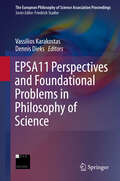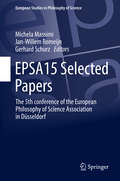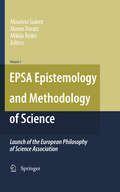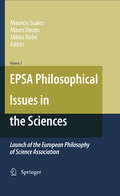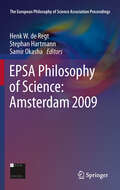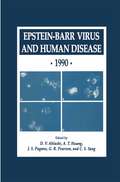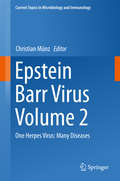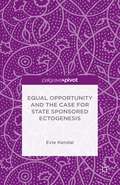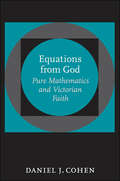- Table View
- List View
EPR: Instrumental Methods (Biological Magnetic Resonance #21)
by Lawrence J. Berliner Christopher J. BenderElectron magnetic resonance spectroscopy is undergoing something akin to a renaissance that is attributable to advances in microwave circuitry and signal processing software. EPR: Instrumental Methods is a textbook that brings the reader up to date on these advances and their role in providing better experimental techniques for biological magnetic resonance. Chapters in this book guide the reader from basic principles of spectrometer design through the advanced methods that are providing new vistas in disciplines such as oximetry, imaging, and structural biology. Key Features: Spectrometer design, particularly at low frequencies (below X-band), Design of spectrometer components unique to ENDOR and ESEEM, Optimization of EMR spectrometer sensitivity spanning many octaves, Algorithmic approach to spectral parameterization, Application of Fourier Methods to polymer conformation, oximetry, and imaging.
EPR of Free Radicals in Solids: Trends in Methods and Applications (Progress in Theoretical Chemistry and Physics #10)
by Anders Lund Masaru ShiotaniEPR of Free Radicals in Solids: Trends in Methods and Applications presents methods and applications of modern EPR for the study of free radical processes in solids, which so far are only available in the journal literature. The first part of the book, covering trends in methods, contains experimentally oriented chapters on continuous wave and pulsed EPR techniques and special methods involving muon magnetic resonance and optical detection and theory for dynamic studies. New simulation schemes, including the influence of dynamics, are presented as well as advances in the calculation of hyperfine and electronic g-tensors. The second part of the book presents applications involving studies of radiation and photo-induced inorganic and organic radicals in inert matrices, including novel results of quantum effects in small radicals. High-spin molecules and complexes are also considered as well as radical processes in photosynthesis. Recent advances in EPR dosimetry are summarized.
EPR of Free Radicals in Solids I: Trends in Methods and Applications (Progress in Theoretical Chemistry and Physics #24)
by Anders Lund and Masaru ShiotaniEPR of Free Radicals in Solids: Trends in Methods and Applications, 2nd ed. presents a critical two volume review of the methods and applications of EPR (ESR) for the study of free radical processes in solids. Emphasis is on the progress made in the developments in EPR technology, in the application of sophisticated matrix isolation techniques and in the advancement in quantitative EPR that have occurred since the 1st edition was published. Improvements have been made also at theoretical level, with the development of methods based on first principles and their application to the calculation of magnetic properties as well as in spectral simulations. EPR of Free Radicals in Solids I focuses on the trends in experimental and theoretical methods to extract structural and dynamical properties of radicals and spin probes in solid matrices by continuous wave (CW) and pulsed techniques. It presents simulation techniques and software for CW and pulsed EPR as well as studies of quantum effects at low temperature. The chapters dealing with quantum chemistry methods for the theoretical interpretation of hyperfine coupling tensors and g-tensors have been much extended in this edition and a new chapter on the calculation of zero-field splitting tensors has been added. This new edition is a valuable resource to experimentalists and theoreticians in research involving free radicals, as well as for students of advanced courses in physical chemistry, chemical physics, materials science, biophysics, biochemistry and related fields. This new edition is a valuable resource to experimentalists and theoreticians in research involving free radicals, as well as for students of advanced courses in physical chemistry, chemical physics, materials science, biophysics, biochemistry and related fields.
EPR of Free Radicals in Solids II: Trends in Methods and Applications (Progress in Theoretical Chemistry and Physics #25)
by Anders Lund and Masaru ShiotaniEPR of Free Radicals in Solids: Trends in Methods and Applications, 2nd ed. presents a critical two volume review of the methods and applications of EPR (ESR) for the study of free radical processes in solids. Emphasis is on the progress made in the developments in EPR technology, in the application of sophisticated matrix isolation techniques and in the advancement in quantitative EPR that have occurred since the 1st edition was published. Improvements have been made also at theoretical level, with the development of methods based on first principles and their application to the calculation of magnetic properties as well as in spectral simulations. EPR of Free Radicals in Solids II focuses on the trends in applications of experimental and theoretical methods to extract structural and dynamical properties of radicals and spin probes in solid matrices by continuous wave (CW) and pulsed techniques in nine chapters written by experts in the field. It examines the studies involving radiation- and photo-induced inorganic and organic radicals in inert matrices, the high-spin molecules and metal-based molecular clusters as well as the radical pro-cesses in photosynthesis. Recent advancements in environmental applications in-cluding measurements by myon resonance of radicals on surfaces and by quantitative EPR in dosimetry are outlined and the applications of optical detection in material research with much increased sensitivity reviewed. The potential use of EPR in quantum computing is considered in a newly written chapter. This new edition is aimed to experimentalists and theoreticians in research involving free radicals, as well as for students of advanced courses in physical chemis-try, chemical physics, materials science, biophysics, biochemistry and related fields.
EPR Spectroscopy: Fundamentals and Methods (eMagRes Books)
by Daniella Goldfarb Stefan StollThis unique, self-contained resource is the first volume on electron paramagnetic resonance (EPR) spectroscopy in the eMagRes Handbook series. The 27 chapters cover the theoretical principles, the common experimental techniques, and many important application areas of modern EPR spectroscopy. EPR Spectroscopy: Fundamentals and Methods is presented in four major parts: A: Fundamental Theory, B: Basic Techniques and Instrumentation, C: High-Resolution Pulse Techniques, and D: Special Techniques. The first part of the book gives the reader an introduction to basic continuous-wave (CW) EPR and an overview of the different magnetic interactions that can be determined by EPR spectroscopy, their associated theoretical description, and their information content. The second provides the basics of the various EPR techniques, including pulse EPR, and EPR imaging, along with the associated instrumentation. Parts C and D builds on parts A and B and offer introductory accounts of a wide range of modern advanced EPR techniques, with examples of applications. The last two parts presents most of the new advances that do not appear in most of the classical EPR textbooks that focus on CW EPR. EPR Spectroscopy: Fundamentals and Methods contains, in concise form, all the material needed to understand state-of-the-art EPR spectroscopy at the graduate school/research level, whilst the editors have ensured that it presents the topic at a level accessible to newcomers to the field and others who want to know its range of application and how to apply it.
EPR Spectroscopy: Fundamentals and Methods (eMagRes Books)
by Daniella Goldfarb Stefan StollThis unique, self-contained resource is the first volume on electron paramagnetic resonance (EPR) spectroscopy in the eMagRes Handbook series. The 27 chapters cover the theoretical principles, the common experimental techniques, and many important application areas of modern EPR spectroscopy. EPR Spectroscopy: Fundamentals and Methods is presented in four major parts: A: Fundamental Theory, B: Basic Techniques and Instrumentation, C: High-Resolution Pulse Techniques, and D: Special Techniques. The first part of the book gives the reader an introduction to basic continuous-wave (CW) EPR and an overview of the different magnetic interactions that can be determined by EPR spectroscopy, their associated theoretical description, and their information content. The second provides the basics of the various EPR techniques, including pulse EPR, and EPR imaging, along with the associated instrumentation. Parts C and D builds on parts A and B and offer introductory accounts of a wide range of modern advanced EPR techniques, with examples of applications. The last two parts presents most of the new advances that do not appear in most of the classical EPR textbooks that focus on CW EPR. EPR Spectroscopy: Fundamentals and Methods contains, in concise form, all the material needed to understand state-of-the-art EPR spectroscopy at the graduate school/research level, whilst the editors have ensured that it presents the topic at a level accessible to newcomers to the field and others who want to know its range of application and how to apply it.
EPR Spectroscopy: Applications in Chemistry and Biology (Topics in Current Chemistry #321)
by Malte Drescher and Gunnar JeschkeEPR Spectroscopy in Catalysis, by Sabine Van Doorslaer und Damien M. Murphy Radicals in Flavoproteins, by Erik Schleicher und Stefan Weber EPR Spectroscopy in Polymer Science, by Dariush Hinderberger EPR in Protein Science, by Intrinsically Disordered Proteins, by Malte Drescher Site-Directed Spin Labeling of Membrane Proteins, by Enrica Bordignon Structure and Dynamics of Nucleic Acids, by Ivan Krstić, Burkhard Endeward, Dominik Margraf, Andriy Marko und Thomas F Prisner New Directions in Electron Paramagnetic Resonance Spectroscopy on Molecular Nanomagnets, by J. van Slageren
EPSA11 Perspectives and Foundational Problems in Philosophy of Science (The European Philosophy of Science Association Proceedings #2)
by Vassilios Karakostas and Dennis DieksThis book contains a selection of original conference papers covering all major fields in the philosophy of science, that have been organized into themes. The first section of this volume begins with the formal philosophy of science, moves on to idealization, representation and explanation and then finishes with realism, anti-realism and special science laws. The second section covers the philosophy of the physical sciences, looking at quantum mechanics, spontaneous symmetry breaking, the philosophy of space and time, linking physics and metaphysics and the philosophy of chemistry. Further themed sections cover the philosophies of the life sciences, the cognitive sciences and the social sciences. Readers will find that this volume provides an excellent overview of the state of the art in the philosophy of science, as practiced in different European countries.
EPSA15 Selected Papers: The 5th conference of the European Philosophy of Science Association in Düsseldorf (European Studies in Philosophy of Science #5)
by Michela Massimi Jan-Willem Romeijn Gerhard SchurzThis edited collection showcases some of the best recent research in the philosophy of science. It comprises of thematically arranged papers presented at the 5th conference of the European Philosophy of Science Association (EPSA15), covering a broad variety of topics within general philosophy of science, and philosophical issues pertaining to specific sciences. The collection will appeal to researchers with an interest in the philosophical underpinnings of their own discipline, and to philosophers who wish to study the latest work on the themes discussed.
EPSA Epistemology and Methodology of Science: Launch of the European Philosophy of Science Association
by Mauricio Suárez Miklós Rédei Mauro DoratoThese two volumes containa selection of the papers delivered at the rst conference of the European Philosophy of Science Association (EPSA) which took place in Madrid,at Complutense University,from 14 to 17 November 2007.
EPSA Philosophical Issues in the Sciences: Launch of the European Philosophy of Science Association
by Mauricio Suárez Mauro Dorato Miklós RédeiThis volume collects papers presented at the Founding Conference of the European Philosophy of Science Association meeting, held November 2007. It provides an excellent overview of the state of the art in philosophy of science in different European countries.
EPSA Philosophy of Science: Amsterdam 2009 (The European Philosophy of Science Association Proceedings #1)
by Henk W. W. de Regt, Stephan Hartmann and Samir OkashaThis is a collection of high-quality research papers in the philosophy of science, deriving from papers presented at the second meeting of the European Philosophy of Science Association in Amsterdam, October 2009.
Epstein-Barr Virus and Human Cancer (Current Topics in Microbiology and Immunology #258)
by K. TakadaIn this book, outstanding researchers from the US and Japan review recent progress in Epstein-Barr virus research. Most people carry EBV in memory B-cells in a latent stage. Many malignancies such as T/NK cell lymphoma, AIDS-associated B-cell lymphoma, gastric carcinoma and Hodgkin's disease have been causally linked to EBV. The development of molecular biology technique has allowed us to study the roles of individual EBV genes that act in the maintenance and disruption of EBV latency.
Epstein-Barr Virus and Human Disease • 1988 (Experimental Biology and Medicine #20)
by D. V. Ablashi A. Faggioni G. R. F. Krueger J. S. Pagano G. R. PearsonEpstein-Barr virus (EBV) is one of the most widespread human viruses, with over 80% of the general population exposed by young adulthood, as determined by antibody studies. Initial infection usu ally occurs during childhood or the teenage years. It is clear that, de pending on the age of the recipient, clinical manifestations of the primary infection can vary. It has been known for 20 years that EBV is the etiologic agent of acute infectious mononucleosis (IM) and is also closely associated with African Burkitt's lymphoma (BL) and naso it is a pharyngeal carcinoma (NPC). There is increasing evidence that factor in the etiology of B-celllymphomas, which arise at a high fre quency in immunodeficient populations. EBV may also contribute to the development of autoimmune disease. Thus, this virus continues to attract world-wide attention. The major target cell for EBV infection has now been conclusively identified as the complement receptor-type 2 (CR2), the Cd/Cdg 3 3 receptor on B lymphocyte. It is apparent, however, that other cells also can become infected by EBV, such as epithelial cells in the parotid gland and other epithelial cells in the upper respiratory tract. This might help account for the EBV-assodated carcinomas of the upper respiratory tract. The first in a series of international symposia on EBV -associated diseases focused primarily on Burkitt's-type lymphomas or on NPC (Kyoto 1977; Dusseldorf 1980; Kuala Lumpur 1982) and emphasized mainly the clinical elements of these diseases. Subsequent symposia (Loutraki, 1984; St.
Epstein-Barr Virus and Human Disease · 1990 (Experimental Biology and Medicine #24)
by D. V. Ablashi A. T. Huang J. S. Pagano G. R. Pearson C. S. YangThe Epstein-Barr virus (EBV), isolated in 1966, continues to draw worldwide attention as an important human pathogen. Its impor tance is largely related to the continuing accumulation of evidence that implicates EBV as an etiological factor for certain types of human cancer. More recent investigations on this virus have focused on the identity of the viral genes responsible for the different disease mani festations observed following viral infection. It is hoped that by thorough investigation of this virus, clues to how cancer develops from a normal cell will surface. In addition, many of the gene products are now being exploited for the development of new and more sensitive tests for the diagnosis and clinical management of individu als with EBV -associated diseases. Thus, studies on this virus continue to provide new information of importance to our understanding of the malignant process. In an effort to attract both basic and clinical scientists to the same meeting for purposes of scientific exchange and fostering a closer interaction between these individuals, a series of international symposia was initiated in 1984. The first meeting was held in Loutraki, Greece, and was attended by approximately 100 participants. The second international symposium was held in St. Petersburg, Florida, in 1986, and was attended by approximately twice as many partici pants as attended the Loutraki meeting.
Epstein Barr Virus Volume 2: One Herpes Virus: Many Diseases (Current Topics in Microbiology and Immunology #391)
by Christian MünzEpstein Barr virus (EBV) was discovered as the first human tumor virus around 50 years ago. Since its discovery in Burkitt’s lymphoma it has been associated with various other malignancies, infectious mononucleosis and even autoimmune diseases. The two book volumes on EBV summarize the first 50 years of research on this tumor virus, starting with historical perspectives on discovery, oncogenicity and immune control, reviewing the role that the virus plays in the various associated diseases and concluding with a discussion on how the immune system keeps persistent EBV infection under control in healthy EBV carriers and can be used to treat EBV associated diseases. The respective 32 chapters are written by international experts from three continents for health care providers, biomedical researchers and patients that are affected by EBV. The assembled knowledge should help to understand EBV associated diseases better and to develop EBV specific vaccination in the near future.
eQTL Analysis: Methods and Protocols (Methods in Molecular Biology #2082)
by Xinghua Mindy ShiThis volume details state-of-art eQTL analysis, where interdisciplinary researchers are provided both theoretical and practical guidance to eQTL analysis and interpretation. Chapters guide readers through methods and tools for eQTL and QTL analysis and the usage of such analysis in various scenarios. Written in the highly successful Methods in Molecular Biology series format, chapters include introductions to their respective topics, lists of the necessary materials and reagents, step-by-step, readily reproducible laboratory protocols, and tips on troubleshooting and avoiding known pitfalls. Authoritative and cutting-edge, eQTL Analysis: Methods and Protocols to ensure successful results in the further study of this vital field.
Equal Opportunity and the Case for State Sponsored Ectogenesis
by Evie KendalEctogenesis refers to the artificial gestation of a fetus outside the womb. Despite certain advantages for women's reproductive liberty, feminist groups remain divided regarding this technology. This book argues that reproduction imposes unjust burdens on women, and thus the ideals of equal opportunity demand continued research into ectogenesis.
The Equality Machine: Harnessing Digital Technology for a Brighter, More Inclusive Future
by Orly LobelAN ECONOMIST BEST BOOK OF 2022 At a time when AI and digital platforms are under fire, Orly Lobel, a renowned tech policy scholar, defends technology as a powerful tool we can harness to achieve equality and a better future. Much has been written about the challenges tech presents to equality and democracy. But we can either criticize big data and automation or steer it to do better. Lobel makes a compelling argument that while we cannot stop technological development, we can direct its course according to our most fundamental values. With provocative insights in every chapter, Lobel masterfully shows that digital technology frequently has a comparative advantage over humans in detecting discrimination, correcting historical exclusions, subverting long-standing stereotypes, and addressing the world&’s thorniest problems: climate, poverty, injustice, literacy, accessibility, speech, health, and safety. Lobel's vivid examples—from labor markets to dating markets—provide powerful evidence for how we can harness technology for good. The book&’s incisive analysis and elegant storytelling will change the debate about technology and restore human agency over our values.
Equation of State of Uranium Dioxide: Data Collection
by C. Ronchi I.L. Iosilevski E.S. YakubIn the beginning of the 1990’s, in the course of the events which were rapidly cha- ing the political con?guration of the East European countries, the crisis which - vested the vast research apparatus of the former Soviet Union was entailing con- quences whose dimension and depth were immediately realized by the international scienti?c community. In the same years, however, the most important branch of nuclear energy - searchanddevelopment,inparticularthatconcerning?ssionreactor,wasworldwide undergoing a substantial reduction due to a variety of decisional situations. Yet, paradoxically, it was a very good fortune that a number of concerns on the future of nuclear research were shared by East- and West-European scientists, especially those who were working in advanced ?elds. In fact, the only hope for coping with an uncertain future was to erect bridges between similar institutions and employ safeguarding tactics linked to a long term collaboration strategy. A decade later, this proved to be a winning decision, since the revival of nuclear energy is presently starting from a basis of common intentions and a network of established cooperation, whose seeds are to be searched in those initial, individual e?orts.
Equations from God: Pure Mathematics and Victorian Faith (Johns Hopkins Studies in the History of Mathematics)
by Daniel J. CohenThroughout history, application rather than abstraction has been the prominent driving force in mathematics. From the compass and sextant to partial differential equations, mathematical advances were spurred by the desire for better navigation tools, weaponry, and construction methods. But the religious upheaval in Victorian England and the fledgling United States opened the way for the rediscovery of pure mathematics, a tradition rooted in Ancient Greece.In Equations from God, Daniel J. Cohen captures the origins of the rebirth of abstract mathematics in the intellectual quest to rise above common existence and touch the mind of the deity. Using an array of published and private sources, Cohen shows how philosophers and mathematicians seized upon the beautiful simplicity inherent in mathematical laws to reconnect with the divine and traces the route by which the divinely inspired mathematics of the Victorian era begot later secular philosophies.
The Equations of Life: How Physics Shapes Evolution
by Charles CockellOne of Britain's foremost astrobiologists offers an accessible and game-changing account of life on Earth.__________________Why is all life based on carbon rather than silicon? And beyond Earth, would life - if it exists - look like our own? __________________The puzzles of life astound and confuse us like no other mystery. But in this groundbreaking book, Professor Charles Cockell reveals how nature is far more understandable and predictable than we would think. Breathing new life into Darwin's theory of natural selection, The Equations of Life puts forward an elegant account of why evolution has taken the paths it has. In a captivating journey into the forces that shape living things on Earth, Cockell explains that the fundamental laws of physics constrain nature at every turn. Fusing the latest in scientific research with fascinating accounts of the creatures that surround us, this is a compelling argument about what life can - and can't - be.
The Equations of Materials
by Brian CantorThis primer describes important equations of materials and the scientists who derived them. It provides an excellent introduction to the subject by making the material accessible and enjoyable. The book is dedicated to a number of propositions: 1. The most important equations are often simple and easily explained; 2. The most important equations are often experimental, confirmed time and again; 3. The most important equations have been derived by remarkable scientists who lived interesting lives. Each chapter covers a single equation and materials subject, and is structured in three sections: first, a description of the equation itself; second, a short biography of the scientist after whom it is named; and third, a discussion of some of the ramifications and applications of the equation. The biographical sections intertwine the personal and professional life of the scientist with contemporary political and scientific developments. Topics included are: Bravais lattices and crystals; Bragg's law and diffraction; the Gibbs phase rule and phases; Boltzmann's equation and thermodynamics; the Arrhenius equation and reactions; the Gibbs-Thomson equation and surfaces; Fick's laws and diffusion; the Scheil equation and solidification; the Avrami equation and phase transformations; Hooke's law and elasticity; the Burgers vector and plasticity; Griffith's equation and fracture; and the Fermi level and electrical properties. The book is written for students interested in the manufacture, structure, properties and engineering application of materials such as metals, polymers, ceramics, semiconductors and composites. It requires only a working knowledge of school maths, mainly algebra and simple calculus.






